Firearms become familiar
Once firearms reached Europe in the 13th Century, they swiftly generated a great deal of interest, and smiths began experimenting with different types of barrels, as alchemists continued to explore new pyrotechnic and explosive compounds. These early weapons, and the powder which gave them life, were difficult to handle and were not easily portable; you could not run around the open field shooting at targets right and left. They did, however, work well enough to sustain growing interest and rapid adoption of the technology, especially for the niche of siege warfare. During a siege, armies tended to stay in place, had places behind cover where they could prepare their weapons in relative safety, and time to do so. And sieges took place constantly in medieval warfare, far more often than pitched battles.

Through the 14th Century, something was happening with firearms in Europe. There were several important innovations in the endless quest to make the new cannon and firearms more reliable, versatile, and deadly. These improvements promised to take them beyond the relatively orderly environment of the siege and into the chaotic maelstrom of open field combat. Of course to paraphrase William Gibson, the future may have arrived, but it was not distributed evenly. Not every army had these, and those who did have them didn’t necessarily have the newest or most effective types.
By end of the century in both written sources and in the archeological record we begin to see evidence that some European firearms, and the pyrotechnic compounds they used, were becoming much more sophisticated. Three interesting archeological finds from the Baltic zone around the turn of the century help to capture this transition: The Mörko hand gun, the Danzig handgonne, and the Tannenberg handgonne, all three dated to sometime before 1399.

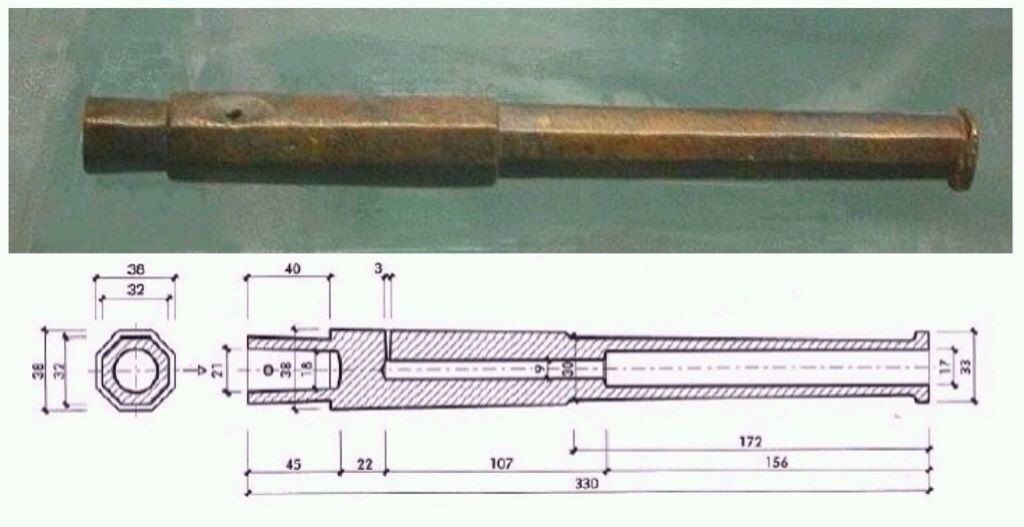

These three weapons were all bronze, which was a popular material for the barrels of early firearms. Bronze doesn’t accidentally spark when struck, helping cut down on accidents, and once a good bronze gun barrel is designed, more copies can be cast quite rapidly. This also means for researchers that bronze replicas can be cast today which are fairly accurate, and these can be used for testing. All three of these weapons showed some advanced features. One trait shared by all three was a ‘stepped’ barrel with a smaller internal chamber for the detonation of the powder, and a larger chamber for the bullet which also allowed the explosive gasses to expand.
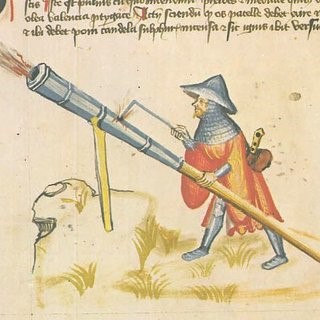
Another trait was the touch hole. This was a separate hole drilled into the firing chamber, allowing priming powder to be ignited from the top instead of down the barrel, making these weapons much easier to handle. The Mörko gun has another feature which was to become commonplace with medieval firearms – a hook. This is what ultimately gives us the name for early firearms, the arquebus – an Anglicization of the German Hacken-Büsche, or “Hook Gun”. The hook was already becoming a very important feature of their use, but we will come back to that later.
It’s worth pointing out something probably obvious for gamers or artists, that these weapons, particularly the Mörko and Danzig pieces with their wonderfully strange faces, have a mysterious, gothic appearance to them highly suitable for genre fiction or RPGs. These weapons, at this time, were still quite mysterious. The people who used them needed to be skilled in alchemy and knowledgeable about pyrotechnics, as they had to mix their own powder and assure that they did not accidentally cause an explosion or a catastrophic fire. The weapons themselves, in a word, were magical.
Our initial perception of medieval firearms was that they were crude and relatively ineffective, sometimes described by 19th or 20th Century historians as ‘mainly noise and smoke makers, used to scare the enemy and their horses.’ This trope was gradually disproven over the last 30-40 years or so, partly from more thorough reading of various literary sources (i.e. period records), and partly due to closer examination and testing of antiques such as these three early firearms. One reason so many firearms were found in the Baltic is that this was an area of ongoing and bitter warfare between several different cultural zones – the Teutonic Knights carried on the Northern Crusades against the Baltic pagans in Lithuania, the Mongols continued to conduct brutal raids deep into Central Europe, and Latin Christian Germans, Poles and Czechs fought with the Orthodox Christian Russians of Muscovy. All the Latin realms and cities also clashed with each other, more or less continuously. So this was a natural place to expect rapid weapon development and the early adoption of new weapons.
When first tested using modern gunpowder, the Tannenberg gun, arguably the most sophisticated of the three mentioned above, produced an energy at the muzzle roughly equivalent to a .357 magnum caliber pistol (about 650 joules). But when tested with ‘serpentine’ black powder of the type used in the 14th Century, with a very different ratio of ingredients (roughly equivalent of Roger Bacon’s second gunpowder formula), the muzzle energy shot up to the equivalent of a .44 magnum (a far more impressive 1100 ft pounds / 1500 joules, with a velocity of 350 meters / ~1100 feet per second), indicating a far deadlier weapon! It’s also notable that the antique two-staged shape of the weapon performed much better than a cylindrical version (more like a modern gun barrel) of the same length. For detailed data about some tests done on this weapon, see here.
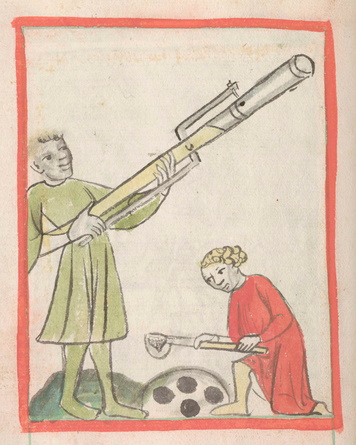
By the turn of the 14th Century firearms and cannon were becoming more popular than ever and improvements were coming fast and furious. More innovations began to appear such as the serpentine, a simple S-shaped lever or hook like device which allowed a smoking medium to be lowered on to the touch hole. Originally a type of fungus was used as the igniter, later, the so-called “slow match’. This was the basis of the trigger used with all modern firearms, and it allowed these weapons to be used with both hands, like a modern firearm, thus improving the potential accuracy a great deal.

In the 1420s, political-religious-sectarian violence which had been simmering for nearly a generation boiled over in Bohemia, (today Czechia). A faction of heretics known as the Hussites (named after a theologian and religious reformer named Jan Hus) formed to defend their land from a Crusade from what is today Germany, but also including knights and soldiers from Burgundy, Poland, Hungary, Italy, Switzerland, England, Castile, Portugal and France.
The Hussite Wars are a big story in their own right, but for our purposes here we can say that everyone expected the Crusaders to swiftly crush the heretics, as was usually the case. But this time, the reverse happened, and firearms are part of the reason why. The Czechs were outnumbered, had fewer experienced warriors, and less equipment, but they had four important assets in their favor: Hundreds of artisans in Prague and their other towns including highly skilled metal workers who were ready to create an arsenal of defense and use it in battle; dozens of educated professors and students from Charles University (also in Prague), including masters of the geometry of Euclid and Vitruvius who could invent new weapon designs; thousands of brave and energetic peasants from the countryside highly motivated to protect their land; and able leadership from the likes of Jan Ziska, a grizzled veteran of wars around Europe (having fought on the winning side at both Grunwald, and according to legend, Agincourt).
The Czechs proved to be both brave and highly innovative, bringing new weapons to the battlefield. From the Czechs in this era, we get two important new English words – pistol (from píšťala, meaning flute) and the howitzer (from houfnice, very roughly ‘crowd hurter’ or ‘gang queller’). What these terms meant in the 1420s was a small, optimized hand-gonne on the one hand, and a small, maneuverable field gun on the other.
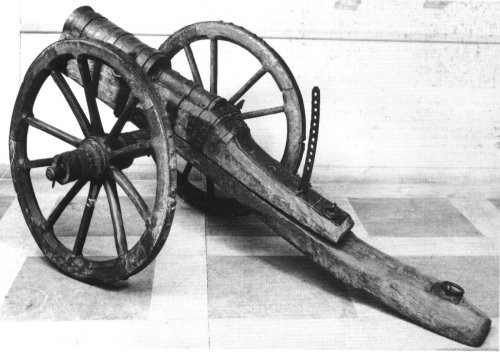
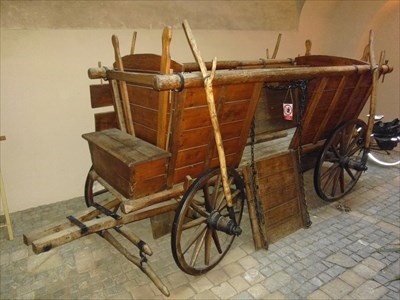
Cannon and firearms had been around for generations as we have already noted, but they were mostly used in sieges. To make these weapons work well in the open field, the Czechs added another innovation, or refinement – the war wagon. This is a subject for another deep dive in its own right, but in its simplest form, this is just a wagon with some extra planks to provide cover, and large spoked wheels to move better over rough terrain. The wagons were used in columns like a mobile fort, and each wagon provided a convenient place to carry heavy firearms and field guns, as well as powder and ammunition, and other weapons and supplies. On defense they could be chained together into a temporary fort. The wagon also, importantly, gave gunners – and also crossbowmen – a helpful platform to rest their weapon on while shooting, much as they would aim over a mantlet or a wall during a siege, which helped a great deal with accuracy.
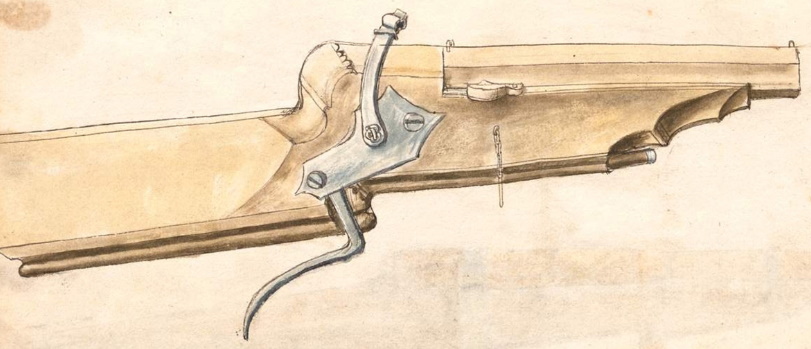
With their war-wagons, the Czechs moved firearms out into the open field and annihilated the first Crusade sent against them, then went on to completely smash a half dozen major invasions which came during the next ten years. When the Catholics refused to make peace, the Czechs went on brutal raids called ‘Beautiful Rides’ to pillage every nearby country. Their neighbors, notably the Germans, developed a superstitious fear of the Czech heretics and their innovative weapons. Eventually against the will of the Vatican, the Germans made a treaty with the Czechs. In the meantime, the princes and many other neighbors of Bohemia, impressed with their fighting abilities, began hiring Czech heretics as mercenaries. Even bishops started doing this. Everyone also began to copy the new Bohemian weapons, including firearms and cannon, but also flails, war wagons and other military innovations.
These new Czech weapons and fighting systems based around the war wagon and gunpowder weapons, turned to be just as effective against the Steppe nomads to the East as they did against Latin Crusaders. They were quickly adopted by the Swiss, Germans, Hungarians, especially the famous Fekete Sereg or Black Army (made up largely of mercenaries) which had the highest ratio of handgunners of any army in the world at the time, the Cossacks of what is today Ukraine, the Muscovites of what is today Russia, and eventually the Ottoman Empire. For more about the Ottoman use of Czech style war-wagons this is a very good article.
For roughly 70 years from the end of the first round of Hussite Wars, the war wagon system was the most reliable and popular model for the use of firearms in Central and Eastern Europe. However, other tactics were being developed simultaneously as the weapons became better understood and more reliable. The invention of crumbled and then corned powder some-time in the mid-15th Century meant that black powder did not have to be re-mixed on a daily basis and could be measured out in advance. Gunners started carrying little paper, wood, or cloth packets with a pre-measured load of powder, primer, and a bullet. This later became the basis of the modern bullet cartridge. The innovation of the paper cartridge, such as it was in the 15th Century, already greatly increased the rate of fire of a handgunner, and this in turn meant they could more easily defend themselves out in the open field, without needing to rely on wagons for cover.
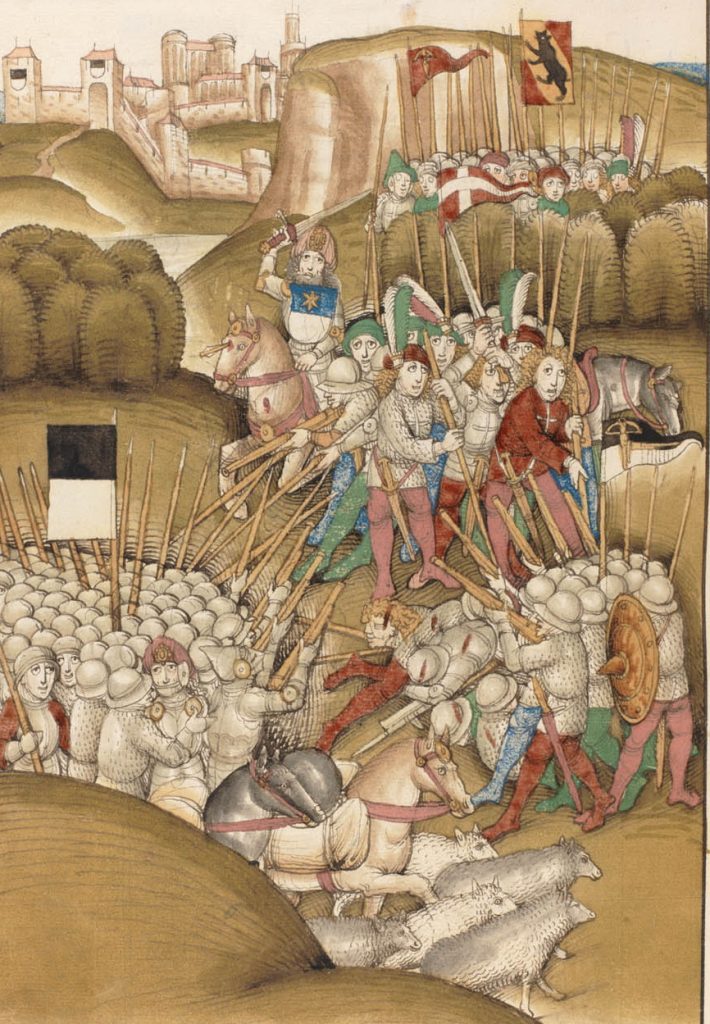
Swiss, Italian and German armies by the mid-15th Century were sending out small forces of skirmishers armed with firearms and crossbows (the two weapons were still being used on a roughly equivalent basis at this point) who could shoot, move, redeploy and shoot again. These proved very useful for reconnaissance, to harass the enemy, and to prevent them from moving or redeploying while the main force (usually pikes) moved into position. The firearm still wasn’t the main weapon of the medieval battlefield, but it was an increasingly important one.
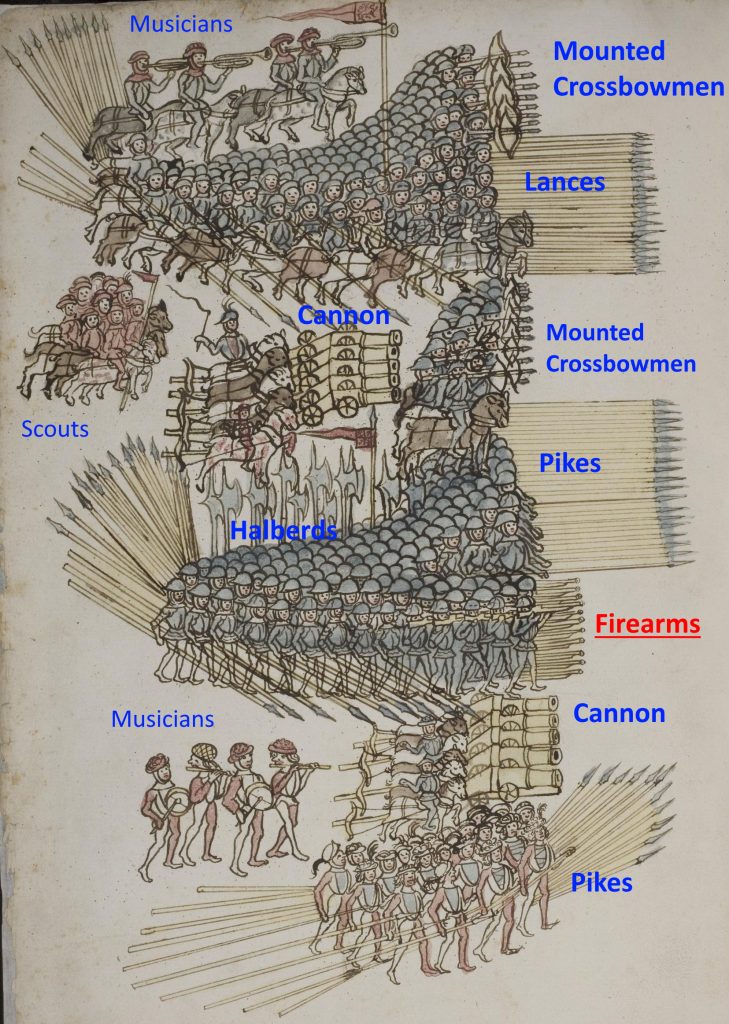
Armies in this period also began to integrate handgunners into the ranks of their main forces, alongside pikes and other types of pole-weapons, various types of cavalry, and cannon. Firearms were commonplace on the battlefield throughout the period of the rise of plate armor.
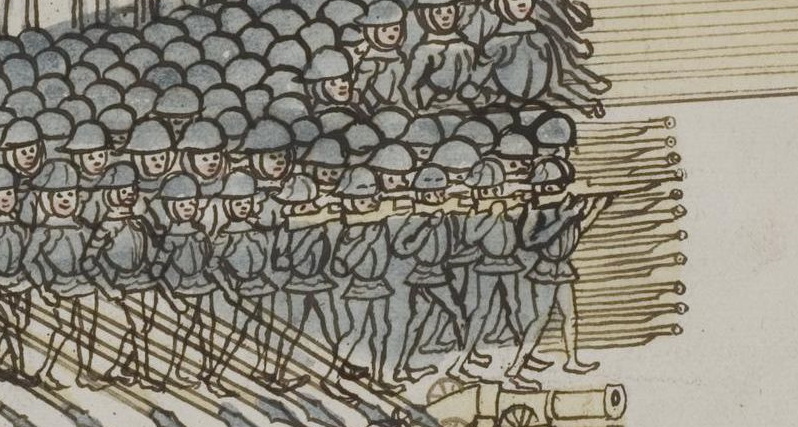
Increasingly though gradually over the 16th Century, pikes and firearms came to dominate the mix of weapons used by the infantry forces. New, more powerful handguns, called muskets, appeared on the battlefields in the late 15th Century, and proved increasingly (if not always) capable of contending with even the best armor. Heavy cavalry, and knights, already threatened by cannon, had long since shifted from the dominant role in battle, to being another tool in the arsenal of a combined-arms force, along with light cavalry, light and heavy infantry, and cannon.
Meanwhile, whereas medieval handgunners were often highly skilled burghers who charged a premium as mercenaries, by the 16th Century princes, the aristocratic rulers of the medieval world, were learning how to train unskilled (but easier to control and cheaper to hire) peasant recruits in the use of ever simpler firearms. This was destined to change the political map of Europe, especially as gold and silver began to pour in to the princely coffers from the New World and the Pacific, though once again, this was a process which took a while to complete (arguably during the apocalyptic 30 Years War of the 17th Century).
Selected antique firearms from 1450-1890:
https://www.feuerwaffen.ch/index_htm_files/Type_03_Musket_X.pdf
For much more about the Hussite Crusades, and their weapons and tactics, see our Codex Guide to the Medieval Baltic Volume I and Volume II


